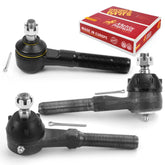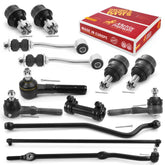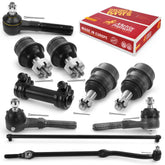Greaseable vs. Non-Greaseable Joints — Which is Best for You?

Ball joints are a critical component of your car’s drive shaft. The drive shaft makes your car steerable and helps it drive properly, and the ball joint helps make the steering motion possible. The debate about whether a greaseable or non-greaseable ball joint provides the most benefits for a drive shaft has gotten more ferocious in recent years. Understanding what makes each version tick and how they differ is important before deciding which to use.
The Main Function of a Ball Joint in a Drive Shaft
A vehicle’s drive is a complex piece of machinery with multiple moving parts working together to help steer a car. Connections to the undercarriage link to the front and rear tires and, when working properly, enables you to navigate your vehicle with ease. Ball joints are the connection point for the wheel hubs to your shaft’s control arms. They provide the pivoting action between the hub and control arms for a smooth driving experience.
How Does a Greaseable or Non-Greaseable Ball Joint Affect This?
When it comes to the life of your vehicle’s ball joints, how well it maintains its ability to pivot dictates how long you have to change it out. These joints require a certain amount of grease to allow them to move within the joint without grinding against the metal. The differences between greaseable and non-greaseable joints play a direct role in this function.
What Is a Greaseable Ball Joint?
Greasable ball joints allow you to periodically reapply grease to give your ball joints a chance at a longer life. They are not sealed, allowing the oil to flow freely and coat the joint, helping everything move freely within the joint. However, water, dirt, and grit can get inside the ball joint and cause the joint to deteriorate more quickly.
How Does a Non-Greaseable Joint Differ?
Non-greaseable joints, on the other hand, are completely sealed, designed to keep the grease inside the joint and keep any contaminants out like dirt and oil that can negatively affect your joint. The sealed joints offer enhanced strength over their greaseable brethren.
Is There a Significant Difference in Wear and Tear?
A greaseable joint has a slightly longer shelf life because it is not sealed. You can go and reapply grease whenever you hear the grinding and help extend the life of your ball joint. However, reapplying grease can be a tedious process for people to do on their own, and if they take it to their mechanic to get the procedure done, the costs can rise.
A non-greaseable ball joint operates as a closed system on the other side of the equation. Nothing can go in or out while the seal remains intact. So for owners and enthusiasts who know they won’t be using a grease gun to treat their greaseable u-joints, cutting out the middleman and going with the non-greaseable option is the way to go.
Trust Metrix Premium Chassis Parts With Your Ball Joints!
When you need to get new non-greaseable or greaseable ball joints for your vehicle, you want to ensure you get one that can hold up to the constant wear and tear. At Metrix Premium Chassis Parts, we see to it that every piece that we manufacture meets the highest standards. Our parts will stand the test of time, give you the opportunity to confidently choose which option makes the most sense for you, and get your car back on the road in no time.
Browse through our inventory and find the greaseable and non-greaseable joints that fit your needs today!









